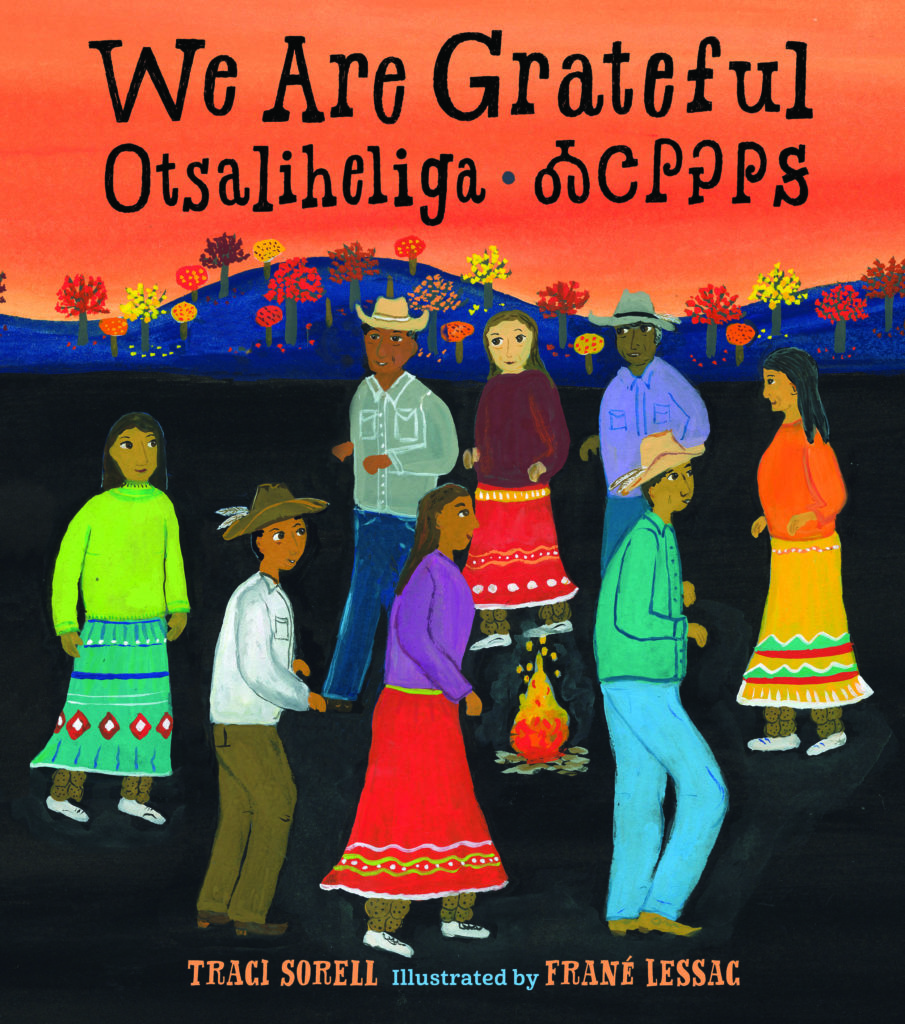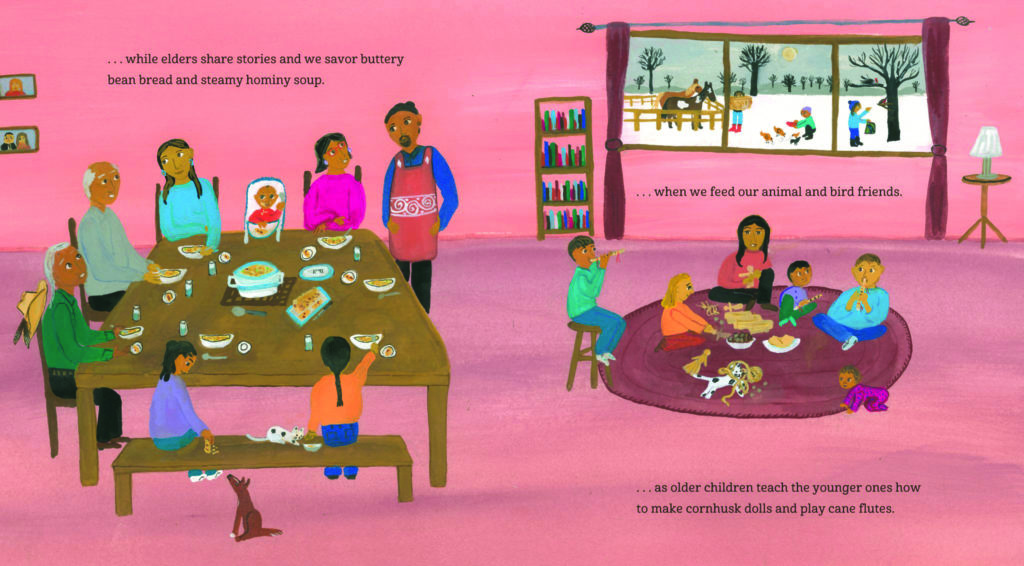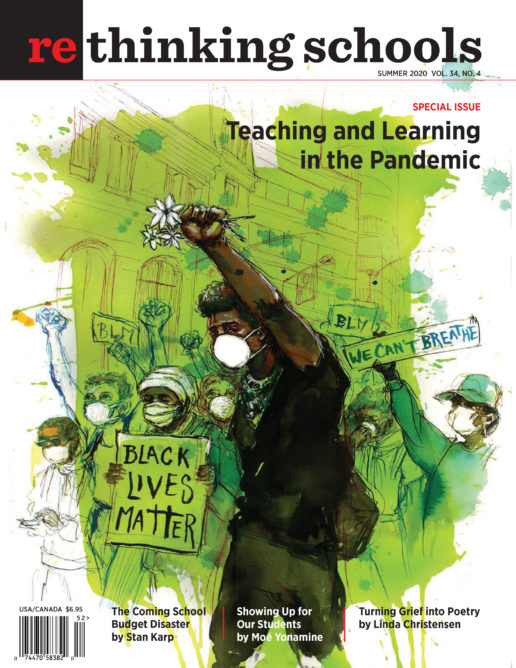A Rhythm of Gratitude

We Are Grateful: Otsaliheliga
By Traci Sorell
Illustrated by Frané Lessac
Charlesbridge Publishing, 2018
My preschool-age children collect treasures from the ground that end up on our table. Bits of moss, Douglas fir cones, drying acorns, prickly sweet gum seed balls, the curling top of a sword fern frond, spruce cones. A rose hip stuffed with coated seeds. Male and female alder catkins. Deodar cedar cones.
The mud we’ve collected by handfuls I leave in a bag on the front porch along with sticks — and the cattail flowers that puff seeds at the slightest movement.
The interest and curiosity of my children seem to be as abundant as the gifts that surround us. There is little judgment about value or beauty. Each object that catches interest is worthy. They find a rock or dandelion as fascinating as a brightly colored tulip. A crow’s call is celebrated as enthusiastically as an ant crawling across the kitchen floor. Novelty is not correlated with finding something new but, instead, with encountering the gift of a new moment.
The new moments we are encountering in the COVID-19 pandemic are readily apparent. So much has changed. These are moments of huge inequities and injustices, and we need to teach about those. But we also need joy. Gratitude.
When my son received Traci Sorell’s debut picture book We Are Grateful: Otsaliheliga as a gift in 2019, I marveled at its simple structure and deep meaning. Now, in these moments of the pandemic, I see it as a lyric balm. On the first page, Sorell, a citizen of the Cherokee Nation, explains:
Cherokee people say otsaliheliga to express gratitude. It is a reminder to celebrate our blessings and reflect on struggles — daily, throughout the year, and across the seasons.
Beautiful, detailed illustrations of present-day Cherokee and their families echo the refrains “we are grateful” and “we say otsaliheliga” as Sorell poetically describes everyday life and Cherokee culture across the seasons of the year. The book is an invitation to be grateful as a rhythm, as a way of living. Gratitude marks the feeding of animals in winter; the planting of ani, strawberries; an uncle’s death.

The obvious teaching potential of We Are Grateful: Otsaliheliga is as a model for a poem, narrative, or essay in an elementary classroom. Even as an adult, I am drawn to the rhythm as a possible poetic response to the current moments of a pandemic: “While . . . As . . . We say otsaliheliga. We are grateful.” As a mother and former bilingual teacher, I am also drawn to the words and pictures that offer a window into present-day Cherokee culture, and the way the text includes Cherokee words and pronunciation, along with a Cherokee syllabary at the end. It is an invitation to be grateful for moments and seasons — also heritage and language.
But gratitude is not an end in and of itself. As Robin Wall Kimmerer writes in the chapter “Allegiance to Gratitude” in her beautiful book Braiding Sweetgrass:
Cultures of gratitude must also be cultures of reciprocity. Each person, human or no, is bound to every other in a reciprocal relationship. Just as all beings have a duty to me, I have a duty to them. If an animal gives its life to feed me, I am in turn bound to support its life. If I receive a stream’s gift of pure water, then I am responsible for returning a gift in kind. An integral part of a human’s education is to know those duties and how to perform them.
Looking at We Are Grateful: Otsaliheliga through this lens, I can see reciprocity in many activities Sorell chooses across the seasons: elders sharing stories, feeding animals and birds, older children teaching younger ones, singing traditional lullabies to babies in Cherokee, recalling ancestors’ sacrifices. Reciprocity to nature is also shown in the drawings. In one picture, a child sits on an adult’s shoulders, looking up at a pileated woodpecker on a tree trunk. Wild onions are harvested by hand. An adult and two children kneel in the soil to plant strawberries. One child jumps in a pile of leaves, another carries a branch, a child steps across stones in a stream. Another picture shows buckbrush or honeysuckle draped around a child’s neck like a shawl as it is collected for basket weaving.
Noticing a bird and kneeling in the soil, we deepen our relationship with the earth, one experience at a time, and, hopefully, our sense of responsibility. As we smile at the person behind the mask, thank an essential worker, and create space for a rhythm of gratitude in our teaching, we work toward reciprocity and healing.
Get information about more resources like this by subscribing to Rethinking Schools magazine at bit.ly/SubscribeToRethinkingSchools.

